Okra, also known as lady’s fingers, is a flowering plant widely cultivated for its edible green pods. It’s believed to have originated in Africa and was later introduced to various parts of the world, including the Americas and Asia.
The okra plant is an important crop in many regions due to its nutritional value, versatility in cooking, and various health benefits. It is a good source of fiber, vitamin C, and folate, as well as antioxidants that help boost immunity.
However, despite its many benefits, okra leaves turning yellow is one such issue from which the plant isn’t fully immune. It may cause due to many factors like improper light conditions, pests and diseases, incorrect watering measures etc..
In this article, we’ll explore the possible causes of okra leaves turning yellow and provide tips on diagnosing and treating the problem effectively.
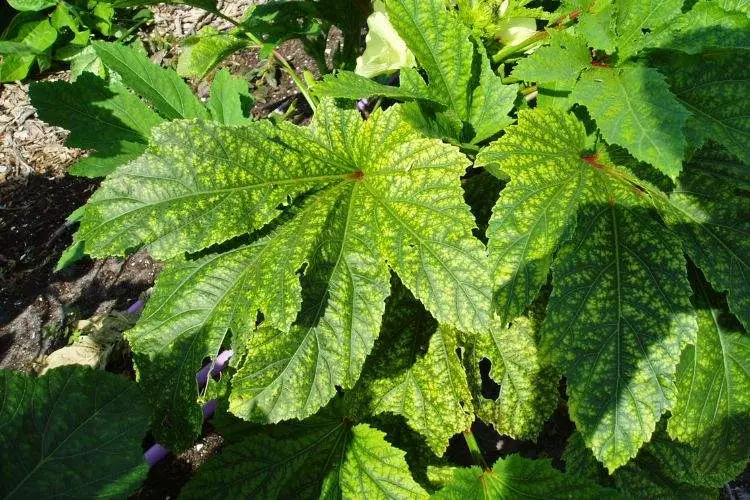
Table of Contents
Possible Causes of Okra Leaves Turning Yellow
Yellowing of okra leaves is a common problem that many factors can cause. In this section, we’ll explore all the possible causes of yellowing in okra leaves and provide insights into the symptoms associated with each.
Understanding the root causes of okra leaves turning yellow is essential in diagnosing and treating the issue effectively. Read on to learn more about the possible culprits behind yellowing okra leaves.
Overwatering
When okra plants are overwatered, the roots can become waterlogged, leading to root rot. This condition prevents the roots from absorbing oxygen properly, which can damage the roots and cause the plant to be unable to absorb nutrients and water properly.
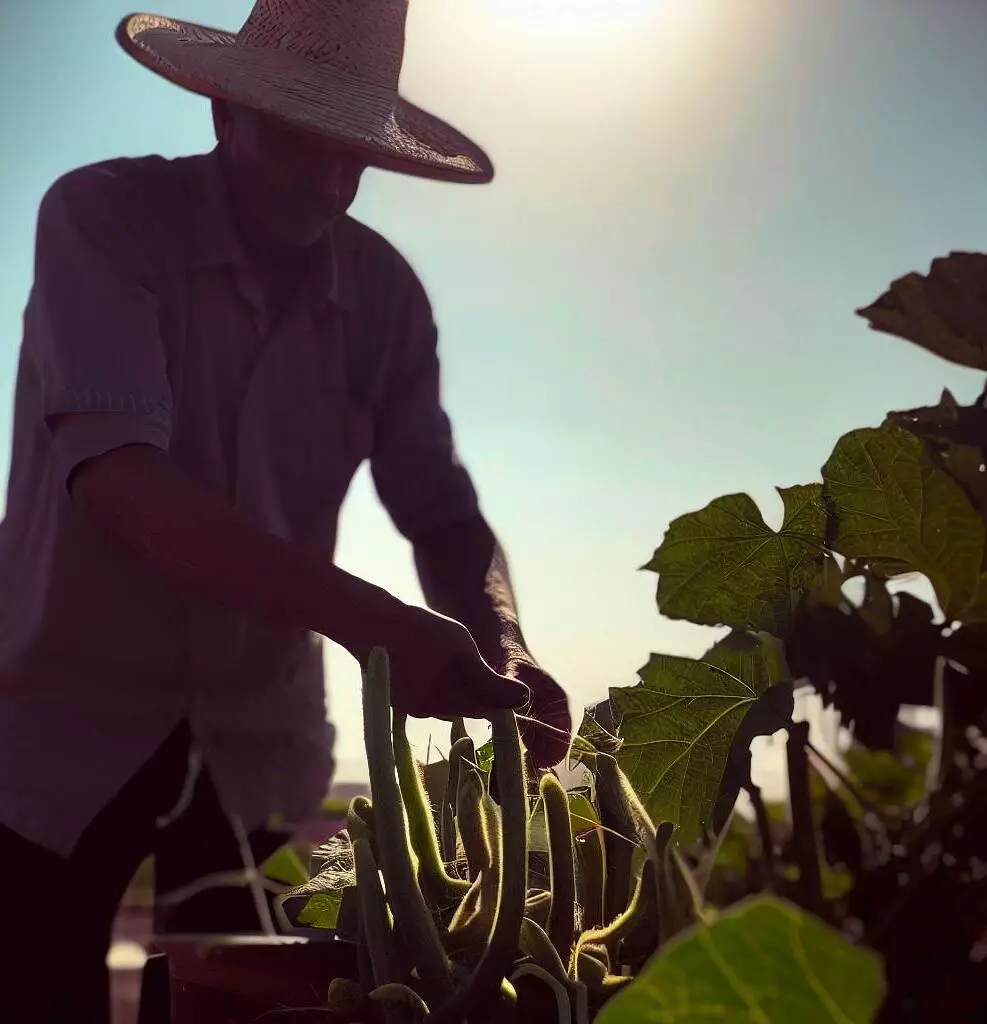
This can lead to yellowing and wilting of leaves due to a lack of chlorophyll, which is needed for photosynthesis. The excess water also encourages the growth of harmful microorganisms that can attack the plant’s root system and reduce its ability to absorb nutrients.
Underwatering
When okra plants are underwatered, they become dehydrated and unable to absorb nutrients, leading to yellowing and dryness of leaves. In this case, the lack of water prevents the plant from producing enough chlorophyll, which is essential for photosynthesis and leads to yellowing of leaves.
Underwatering can also lead to stress on the plant, making it more vulnerable to diseases and pest infestations.
Nutrient Deficiency
A lack of essential nutrients such as nitrogen, potassium, and magnesium can also cause yellowing of okra leaves. These nutrients are vital for the plant to produce chlorophyll, which is essential for photosynthesis.
When these nutrients are lacking, the plant cannot produce enough chlorophyll, leading to yellowing and stunted growth. Nutrient deficiency can also weaken the plant, making it more susceptible to pests and diseases.
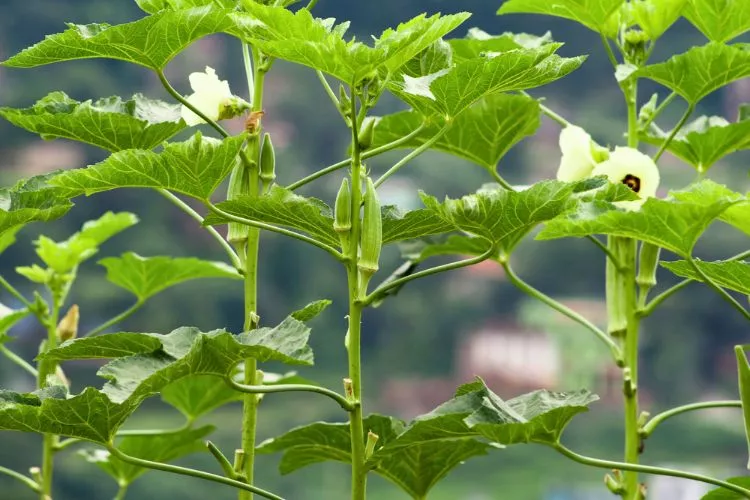
Here’s a brief explanation of how each nutrient deficiency causes the leaves to turn yellow:
- Nitrogen Deficiency: Nitrogen is a crucial nutrient for producing chlorophyll, the pigment that gives leaves their green color and is essential for photosynthesis. When there is a lack of nitrogen, the plant cannot produce enough chlorophyll, leading to yellowing of leaves. This can also cause stunted growth, reduced fruit production, and overall weakness in the plant.
- Potassium Deficiency: Potassium is necessary for many plant processes, including the regulation of water and nutrient transport, enzyme activation, and the production of carbohydrates. When there is a lack of potassium, the plant cannot regulate water properly, leading to the yellowing of leaves, curling of the edges, and even necrosis or death of leaf tissue.
- Magnesium Deficiency: Magnesium is a key component of chlorophyll and is necessary for the absorption of light energy during photosynthesis. When there is a lack of magnesium, the plant cannot produce enough chlorophyll, leading to yellowing of leaves. This deficiency can also cause stunted growth, weak stems, and reduced fruit production.
- Iron Deficiency: Iron is essential for producing chlorophyll and is involved in many other plant processes, including respiration and DNA synthesis. When there is a lack of iron, the plant cannot produce enough chlorophyll, leading to yellowing of leaves. This can also cause stunted growth, weak stems, and reduced fruit production.
- Zinc Deficiency: Zinc is necessary for producing chlorophyll and is involved in synthesising plant hormones and enzymes. When there is a lack of zinc, the plant cannot produce enough chlorophyll, leading to yellowing of leaves. This can also cause stunted growth, reduced fruit production, and even death of leaf tissue.
Pest Infestation
Several pests can affect okra plants, causing damage and discoloration of the leaves. Here are some of the most common pests and how to spot them:
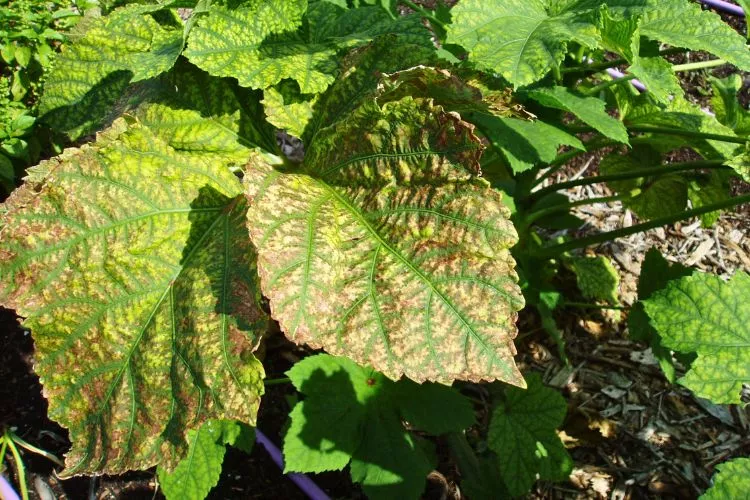
- Aphids: These small, pear-shaped insects feed on the sap of the leaves, causing damage and discoloration. They can be spotted by the clusters they form on the leaves and stems of the plant. Aphids can cause yellowing and curling of the leaves, stunted growth, and even plant death.
- Whiteflies: These small, moth-like insects also feed on the sap of the leaves and can be spotted by the white, powdery substance they leave behind on the leaves. They can cause yellowing and wilting of the leaves, stunted growth, and reduced fruit production.
- Spider Mites: These tiny, spider-like pests also feed on the sap of the leaves and can cause damage and discoloration. They can be spotted by the webbing they leave behind on the leaves and stems of the plant. Spider mites can cause yellowing and curling of the leaves, brown spots, and premature leaf drop.
- Caterpillars: These larvae of moths and butterflies can cause damage to the leaves and fruit of the okra plant. They can be spotted by the holes they leave behind on the leaves and the damage to the fruit. Caterpillars can cause yellowing and wilting of the leaves and reduced fruit production.
- Leafhoppers: These small, wedge-shaped insects feed on the sap of the leaves and can be spotted by the damage they cause. They can cause yellowing and curling of the leaves, stunted growth, and reduced fruit production.
Improper Sunlight Exposure
Okra plants require adequate sunlight to produce chlorophyll, which is needed for photosynthesis. Too much sunlight can cause the leaves to become scorched and brown, while too little sunlight can cause yellowing and weak growth due to a lack of chlorophyll.
Improper sunlight exposure can also affect the plant’s ability to absorb and utilize nutrients properly.
Temperature Issue
Temperature issues can cause stress to the okra plant, leading to yellowing and wilting of leaves. Extreme temperatures can be both hot and cold and harm the plant.
In hot temperatures, the plant may lose water rapidly through transpiration, causing it to become dehydrated and wilted. This can also cause the plant to become heat-stressed, leading to yellowing and browning of leaves and even premature leaf drop.
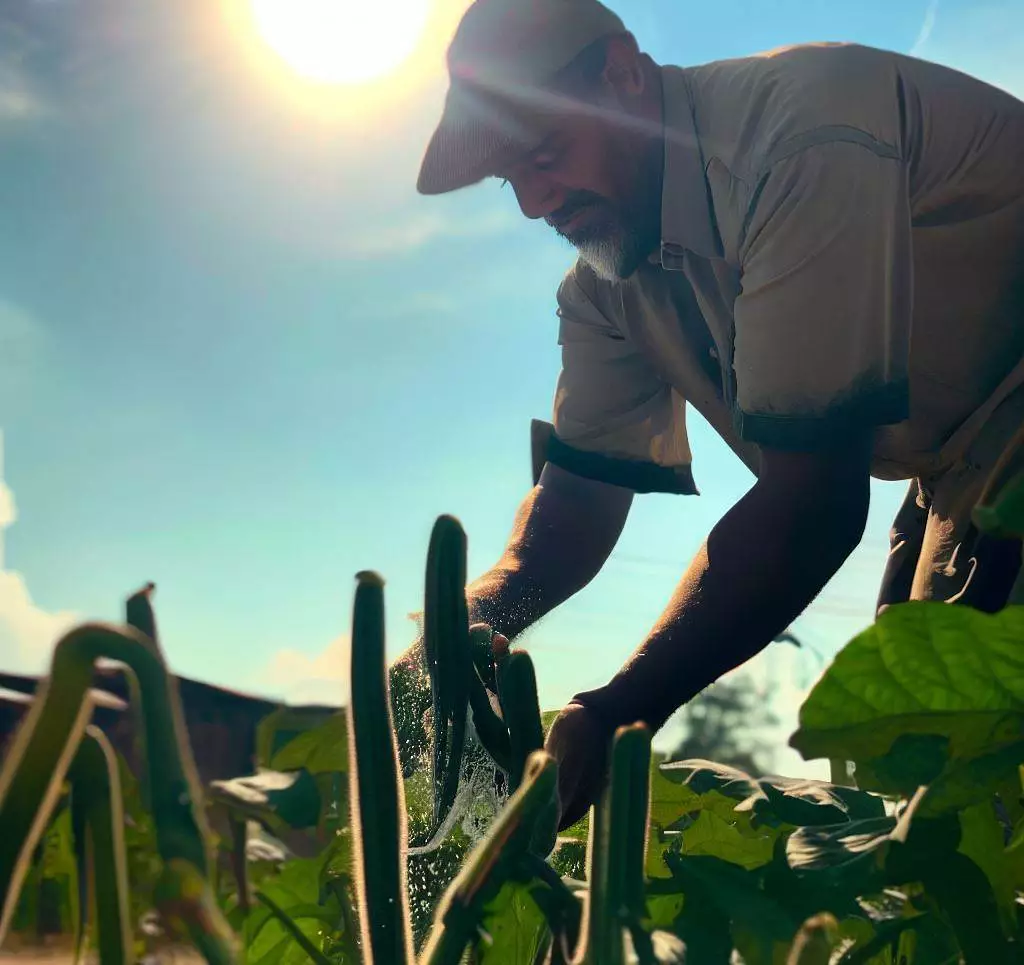
On the other hand, in cold temperatures, the plant may experience frost damage or freezing, leading to damage and discoloration of the leaves. This can also cause the plant to become cold-stressed, leading to yellowing and wilting of leaves and even death of the plant.
It is important to note that the ideal temperature for okra plants is between 70-90°F (21-32°C) during the day and around 60-70°F (15-21°C) at night. Anything outside of this range can cause stress to the plant and lead to yellowing of leaves.
Additionally, sudden fluctuations in temperature can also cause stress and damage to the plant, so it is important to keep the temperature as consistent as possible.
Diseases
Several diseases can affect okra plants, causing damage and discoloration of the leaves. Here are some of the most common diseases and how to spot them:
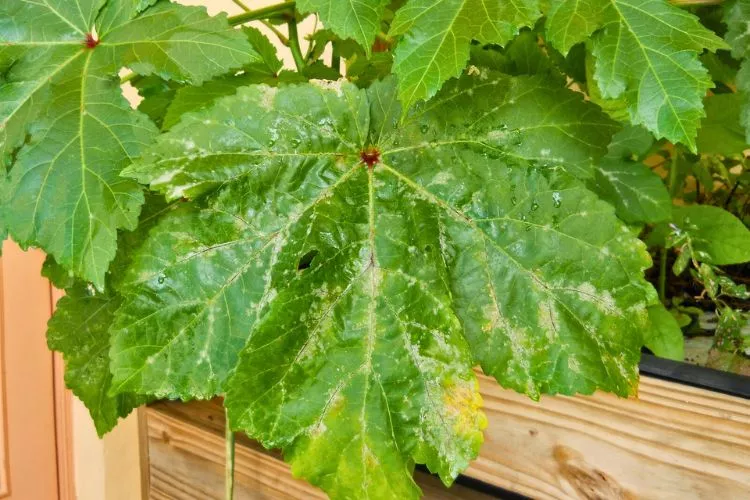
- Fusarium Wilt: This fungal disease causes the plant leaves to turn yellow and wilt. It can be spotted by the discoloration and wilting of the leaves, as well as brown streaks on the stem of the plant. Fusarium wilt can cause stunted growth and reduced fruit production, and it can be spread through contaminated soil, water, and plant debris.
- Bacterial Leaf Spot: This bacterial disease causes the plant leaves to develop yellow spots and brown lesions. The discoloration and lesions on the leaves and the yellowing and premature drop of the affected leaves can spot it. Bacterial leaf spots can cause reduced fruit production and can be spread through contaminated soil, water, and plant debris.
- Southern Blight: This fungal disease causes the plant stems to rot at the soil level, causing the leaves to wilt and turn yellow. It can be spotted by the discoloration and wilting of the leaves, as well as the white fungal growth on the stem of the plant. Southern blight can cause stunted growth and reduced fruit production, and it can be spread through contaminated soil and plant debris.
- Powdery Mildew: This fungal disease causes a white, powdery coating to appear on the plant leaves, which can lead to yellowing and premature leaf drop. It can be spotted by the white coating on the leaves and the yellowing and drop of the affected leaves. Powdery mildew can cause reduced fruit production and can be spread through contaminated soil and plant debris.
Transplant Shock
When okra plants are transplanted, they can experience shock due to environmental changes. This can damage the roots and prevent the plant from producing enough chlorophyll, leading to yellowing and wilting of leaves. Transplant shock can also weaken the plant, making it more vulnerable to pests and diseases.
Natural Aging
As the leaves age, they naturally turn yellow and drop off the plant. This is part of the plant’s natural growth cycle and is not a cause for concern unless excessive yellowing and leaf drop occur. This process occurs because the leaves can no longer produce chlorophyll due to their age and function within the plant.
Signs and Symptoms of Yellowing of Okra Leaves
Now that we have explored the possible causes of yellowing in okra leaves let’s dive into the signs and symptoms of this problem. In this section, we will discuss how yellowing can manifest in the leaves of an okra plant and what those symptoms may indicate.
By understanding these signs and symptoms, we can better diagnose the issue and take appropriate measures to address it.
Yellowing of leaves
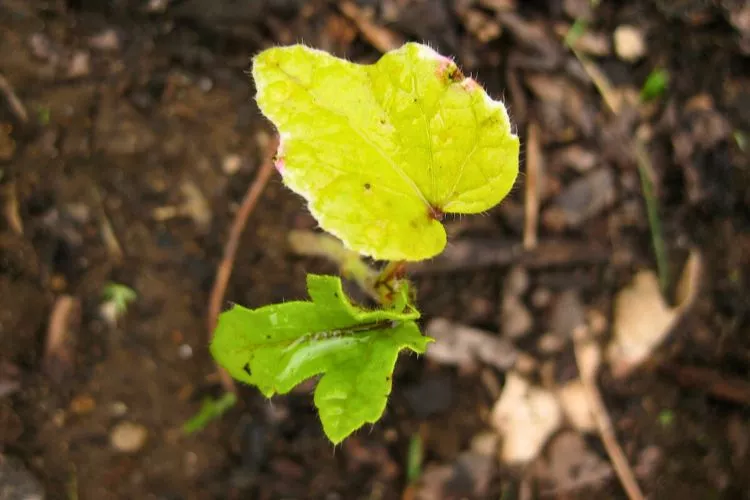
- Causes: There are various reasons why okra leaves may turn yellow, such as over or underwatering, nutrient deficiencies, pest infestations, diseases, and more. When the leaves lack chlorophyll, they cannot carry out photosynthesis properly, which can result in yellowing.
- Diagnosis: To diagnose yellowing leaves, examine the entire plant for other symptoms and take note of any changes in watering, sunlight exposure, or temperature. Check the soil for moisture levels and nutrient balance. If necessary, test the soil for pH and nutrient levels to determine if there are any deficiencies.
Browning of leaves
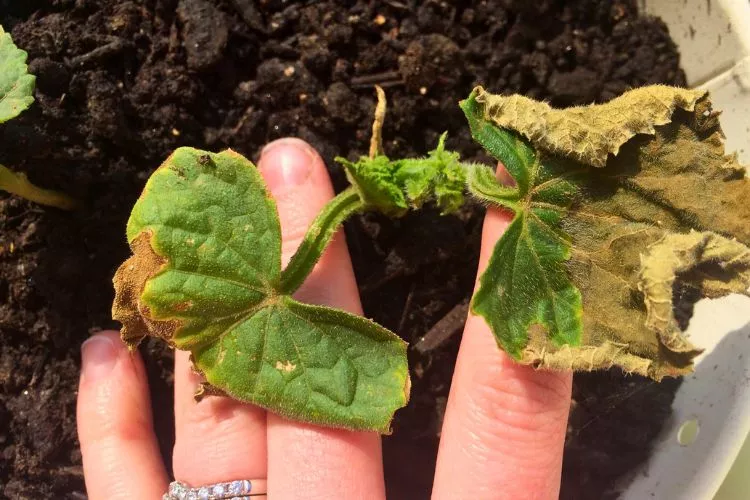
- Causes: Browning of leaves can be caused by a variety of factors, such as exposure to extreme temperatures or sunlight, pest damage, diseases, nutrient deficiencies, or improper watering practices. In some cases, brown spots may appear on the leaves before they turn completely brown.
- Diagnosis: To diagnose browning leaves, examine the entire plant for other symptoms, such as wilting, spots, or discoloration. Check for pests or signs of diseases. Make sure the plant is getting the right amount of sunlight and water. Test the soil for nutrient deficiencies or pH imbalances.
Wilting of leaves
- Causes: Wilting of leaves can be caused by many factors, including underwatering, overwatering, exposure to extreme temperatures, pests, diseases, or transplant shock. When the plant cannot absorb water and nutrients properly, the leaves may wilt or droop.
- Diagnosis: To diagnose wilting leaves, examine the entire plant for other symptoms, such as discoloration or spots on the leaves, and check the soil for moisture levels. Ensure the plant is not over or underwatered, and check for pest infestations or diseases.
Premature leaf drop
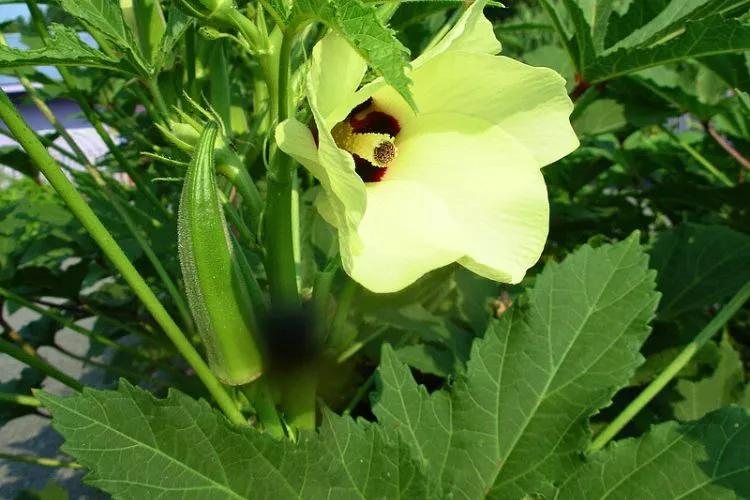
- Causes: Premature leaf drop can be caused by various factors, such as nutrient deficiencies, pest infestations, diseases, exposure to extreme temperatures, or overwatering. When the plant is stressed or unable to absorb nutrients properly, the leaves may drop prematurely.
- Diagnosis: To diagnose premature leaf drop, examine the entire plant for other symptoms, such as discoloration or spots on the leaves, and check for pest infestations or signs of diseases. Ensure the plant gets the right amount of water and nutrients, and check for any nutrient deficiencies.
Stunted growth
- Causes: Stunted growth can be caused by many factors, such as nutrient deficiencies, over or underwatering, improper sunlight exposure, pest infestations, or diseases. When the plant cannot absorb nutrients properly or undergo photosynthesis properly, it may experience stunted growth.
- Diagnosis: To diagnose stunted growth, examine the entire plant for other symptoms, such as yellowing or brown spots on the leaves, and check for pest infestations or signs of diseases. Ensure that the plant gets the right amount of water and nutrients, and check for any nutrient deficiencies or pH imbalances.
Remedies for Yellowing of Okra Leaves
If you notice that your okra leaves are turning yellow, it’s important to take action to address the underlying problem. Fortunately, there are several remedies you can try to restore the health of your plants and prevent further yellowing.
In this section, we’ll explore some of the most effective solutions for yellowing okra leaves and discuss how to implement them effectively.
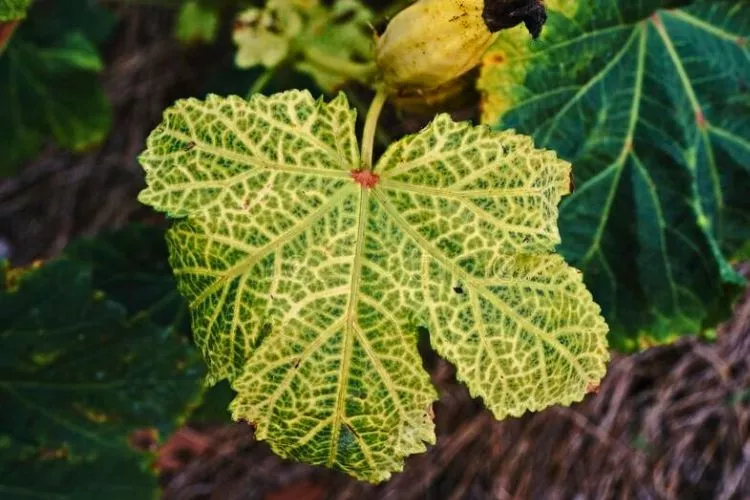
Adjust watering habits
- How to water okra plants properly: Water deeply and infrequently, allowing the top inch of soil to dry out between waterings. Avoid watering the leaves directly to prevent fungal growth.
- How to prevent overwatering and underwatering: Monitor soil moisture regularly and adjust the watering frequency as needed. Use a moisture meter or stick your finger into the soil to test for moisture levels.
Improve soil quality
- How to test soil quality: Use a soil test kit or send a soil sample to a lab for analysis. This will provide information on the pH level, nutrient content, and other factors affecting soil quality.
- How to improve soil quality: Amend the soil with organic matter such as compost, manure, or peat moss. This will improve soil structure, increase nutrient availability, and promote healthy root growth.
Fertilize the plant
- Types of fertilizer for okra plants: Use a balanced fertilizer with equal parts nitrogen, phosphorus, and potassium (NPK). Look for a slow-release or organic fertilizer for long-term benefits.
- How to fertilize okra plants: Apply fertilizer according to the package instructions, usually every 4-6 weeks during the growing season. Avoid over-fertilizing, which can lead to nutrient burn and other problems.
Control pests and diseases
- How to prevent pest infestations: Use natural pest control methods such as neem oil, insecticidal soap, or companion planting with insect-repelling plants. Keep the garden clean and free of debris to reduce pest habitats.
- How to treat common diseases: Use organic fungicides or remove infected plant parts to prevent the spread of disease. Practice good hygiene by sanitizing tools and avoiding overwatering.
Remove infected parts
- How to prune okra plants: Use sharp, clean pruning shears to remove infected or damaged parts. Make clean cuts above a healthy leaf node or stem.
- How to dispose of infected parts: Do not compost infected plant parts, as this can spread disease. Dispose of them in the trash or burn them to prevent contamination.
Adjust Sunlight Exposure and Temperature
- How to adjust sunlight: Monitor the amount of sunlight the plants are getting and adjust the location as needed. If they receive too much sunlight, move them to a shadier location. If they do not receive enough sunlight, move them to a sunnier location or provide supplemental light.
- How to adjust temperature level: Avoid exposing the plants to extreme temperatures, as this can cause stress and yellowing of leaves. Use shading or cover the plants during extreme heat or cold weather.
Prevention of Yellowing of Okra Leaves
Prevention is always better than cure, and this is especially true when it comes to the yellowing of okra leaves. By taking the necessary steps to prevent the problem from occurring in the first place, you can save yourself time, effort, and frustration in the long run.
In this section, we’ll explore some of the best ways to prevent the yellowing of okra leaves and ensure your plants stay healthy and vibrant.
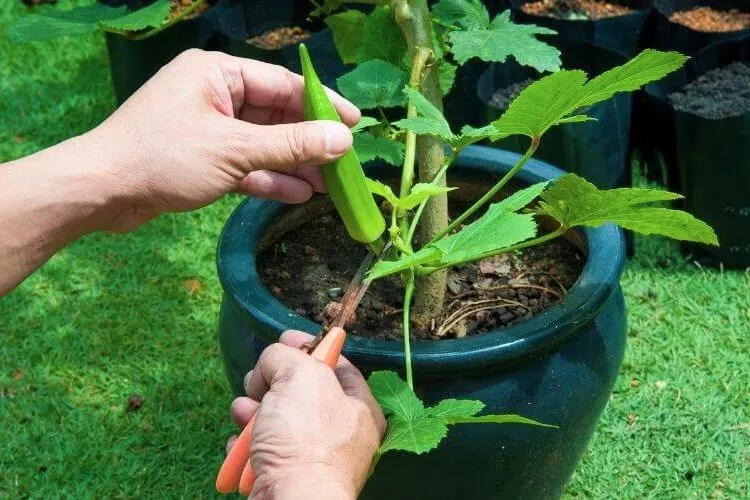
Provide proper drainage
Proper drainage is essential in preventing overwatering, which can lead to yellowing of okra leaves. To improve drainage, add organic matter to the soil, such as compost or peat moss. This can help to improve the soil structure and drainage.
Another option is to add perlite or vermiculite to the soil mix, as these materials can help to increase the pore space in the soil, allowing for better drainage.
Then there is sand, which can also improve drainage but should be used cautiously, as too much sand can lead to soil compaction and reduced water retention.
Additionally, installing a drainage system or using a French drain can help to divert excess water away from the planting area. You can create raised beds or plant okra in containers to improve drainage. To prevent waterlogging, avoid planting okra in low-lying areas or areas prone to flooding.
Choose a sunny location
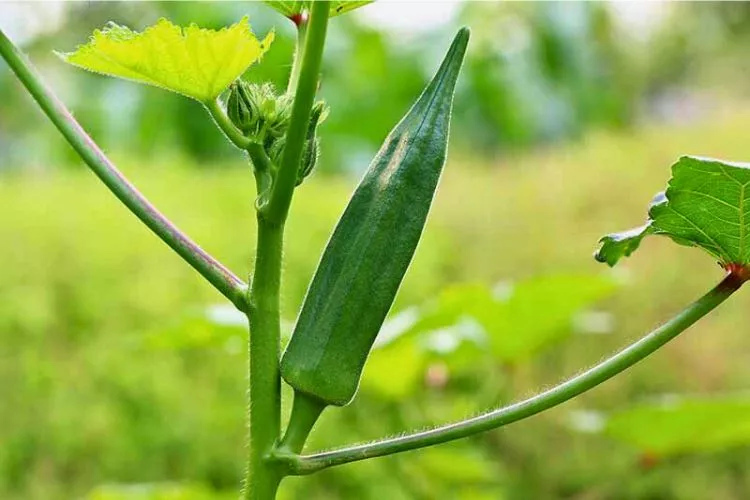
Okra plants require full sun exposure for healthy growth and to prevent yellowing leaves. They need at least 6-8 hours of direct sunlight per day.
When choosing a location to plant okra, look for an area that receives ample sunlight throughout the day. If you live in an area with hot summers, consider providing some shade during the hottest part of the day to prevent the scorching of leaves.
Proper spacing
Okra plants require adequate space for healthy growth and to prevent overcrowding, which can lead to the yellowing of leaves. Space plants 12-18 inches apart to ensure they have room to grow and receive adequate sunlight and nutrients.
When planting multiple rows, leave enough space between the rows for easy access and air circulation.
Crop rotation
Crop rotation can help prevent the buildup of pests and diseases in the soil, leading to the yellowing of okra leaves. To rotate crops, simply plant okra in a different garden area each year. This can also help to improve soil fertility by reducing the depletion of nutrients.
Use of organic pesticides
Using organic pesticides can help prevent pest infestations, which can damage okra leaves and lead to yellowing. Examples of organic pesticides include neem oil, insecticidal soap, and pyrethrin.
When using pesticides, follow the instructions carefully and avoid applying them during the hottest part of the day to prevent damage to the leaves.
Additional Tips and Tricks for Growing Healthy Okra Plants
Beyond the basic care requirements, some additional tips and tricks can help you grow healthy and thriving okra plants. These methods can help you optimize growth, increase yield, and ensure your plants remain disease and pest-free.
This section will explore some additional tips and tricks that can take your okra-growing game to the next level.
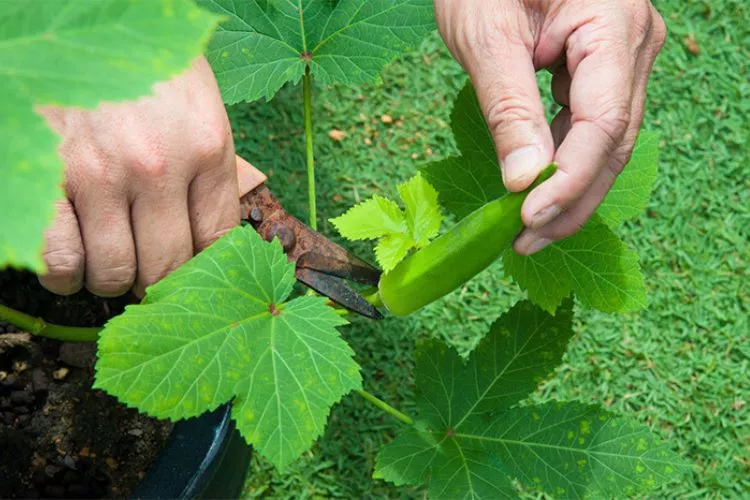
- Companion planting: Companion planting is a gardening technique where different plant species are grown together to enhance their growth, prevent pest infestations, and improve soil health. For example, planting okra alongside marigolds can help to repel harmful nematodes and pests, while planting okra with beans can help to improve soil health by fixing nitrogen. Other compatible plants for okra include peppers, tomatoes, and cucumbers.
- Mulching: Mulching: is the process of covering the soil around the plant with a layer of organic material, such as leaves or straw. Mulching helps to retain soil moisture, prevent weed growth, and regulate soil temperature. In addition, mulch can improve soil fertility by slowly decomposing and releasing nutrients into the soil. To mulch okra plants, spread a layer of organic material around the base of the plant, being careful not to cover the stem.
- Proper Pruning: Proper pruning is essential for maintaining healthy okra plants and promoting fruit production. Pruning involves removing dead or damaged leaves, stems, and branches to encourage new growth and prevent the spread of diseases. To prune okra plants, use clean, sharp pruning shears to reduce damaged or diseased growth. Cut just above a healthy leaf node or bud to encourage new growth.
- Timing of planting and harvesting: Timing and harvesting are important for growing healthy okra plants. Okra should be planted in the spring after the last frost and harvested when the pods are 2-4 inches long and tender. Harvesting regularly, every 1-2 days, can help to promote continuous fruit production and prevent the pods from becoming tough and woody.
- Handling and storage of okra pods: Handling and storage of okra pods is also important to ensure the best quality and taste. Okra should be harvested early in the morning when it is still cool, and the pods are firm. After harvesting, okra should be stored in a cool, dry place and consumed within 2-3 days. Alternatively, okra can be blanched and frozen for long-term storage. When handling okra, be gentle to prevent damage to the delicate pods.
Frequently Asked Questions (FAQs)
How often should I water my okra plant?
Water okra deeply but infrequently when the top 2-3 inches of soil feel dry to the touch.
What kind of fertilizer should I use for my okra plant?
Use a balanced fertilizer with equal parts of the important plant food nutrients: nitrogen, phosphorus, and potassium.
How can I prevent pest infestation on my okra plant?
Use organic pesticides, practice good garden hygiene, and encourage beneficial insects.
Can I still eat the okra pods if the leaves are yellow?
Yes, yellow leaves do not affect the edibility of okra pods.
Conclusion:
In conclusion, the yellowing of okra leaves can be caused by various factors, including overwatering, underwatering, nutrient deficiency, pests, diseases, and more.
Proper watering and fertilization, pest and disease control, adjusting sunlight and temperature exposure, and preventative measures such as crop rotation and companion planting can be helpful in addressing this issue. We hope that this guide on okra leaves turning yellow has been helpful.
You can read about similar topics here on our website. Check back again soon for more.


